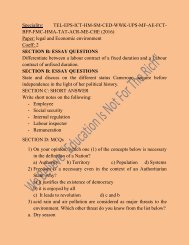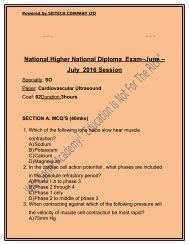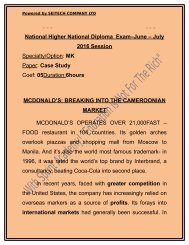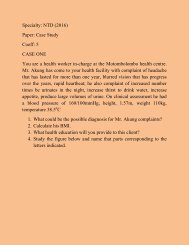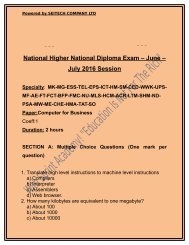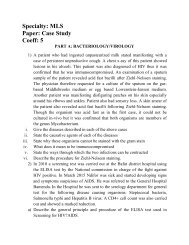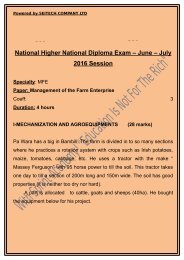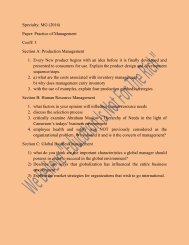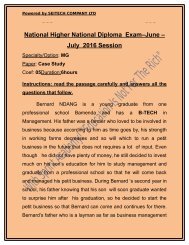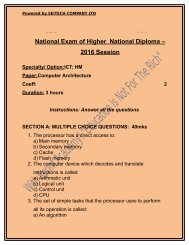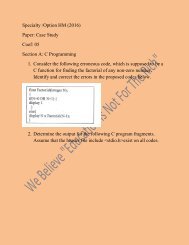UPS(case_study)-min
Create successful ePaper yourself
Turn your PDF publications into a flip-book with our unique Google optimized e-Paper software.
Specialty/Option: <strong>UPS</strong> (2016)<br />
Paper: Case Study<br />
Coef: 05<br />
Instructions: answer one question from each section<br />
Section A: Regional and Development Planning<br />
Questions:<br />
1. Discuss types of regions and their method/criteria of selecting them.<br />
2. Exa<strong>min</strong>e the export base theory for regional growth.<br />
Section B: Project Evaluation<br />
Questions:<br />
3. Account on the social impact of the University of Bamenda when it will be<br />
fully establishment<br />
4. Describe cost <strong>min</strong>imization analysis as applied in project evaluation.<br />
Section C: Planning Studio Practice<br />
Questions:<br />
1. Use figure I, to prepare a residential neighbourhood plan of the area, with<br />
the plot sizes of 20.30m. give a breakdown for your space allocation using<br />
the standards provided. Use A Scale of 1:500<br />
2. Produce a Model of a cloverlead road interchange as shown in figure II. Use<br />
A scale of 1:50<br />
Section D: Project Finance<br />
Questions:<br />
3. Discuss the various participants in project finance and their roles<br />
4. Account on financial resources of council in Cameroon.
Table 1: Space Standard for Residential Layout<br />
Land Use % of developed area Average<br />
Residential dwelling unit 50-60 55<br />
Local shopping 3-4 3.5<br />
Play/open spaces 10-12 11<br />
Roads/streets 12-15 13<br />
Public/semi-public 15-20 17.5<br />
Specialty: MG<br />
Paper: Project Management<br />
Coeff: 3<br />
SECTION A<br />
Question 1:<br />
a) What is the role of a contingency plan in a project?<br />
b) An ambitious and yet realistic goal must meet certain criteria. Name the<br />
criteria that good goal must meet?<br />
c) Why is a well-defined goal and objective necessary for a project<br />
Question 2:<br />
a) What are the features common to all projects?<br />
b) What do you understand by the term project? What is project management<br />
c) Differentiate between project team and project group.<br />
Question 3:<br />
a) Name three project planning tools used in project management<br />
b) State explain any two importance of the critical path to project managers<br />
c) What is scope creep?
Question 4:<br />
a) Most organizations do not have the luxury of perfor<strong>min</strong>g every project that<br />
is proposed. Explain the selection methods that help organization decide<br />
among alternative project?<br />
b) Briefly describe the concept of cost/time trade-off and how it is used<br />
c) Identify any two useful skills that a project manager needs to function in a<br />
modern project like that mentioned above.<br />
Question 5:<br />
a) Distinguish between a large and a complex project<br />
b) Define a work breakdown structure<br />
c) What do you understand by a project team<br />
Question 6:<br />
Briefly discuss the following concepts with examples/illustrations as used project<br />
management<br />
a. Slacks<br />
b. Dummy activities<br />
c. Project schedule<br />
d. Merge activities<br />
e. Work package<br />
SECTION B:<br />
Question 7<br />
An advertising campaign uses a network as shown below:<br />
Activity X M Y<br />
1-2 4 5 6<br />
1-3 3 4 8<br />
2-4 1 2 5<br />
2-5 5 6 9<br />
3-4 2 3 4<br />
3-5 2 3 6<br />
4-6 4 5 6
5-6 3 4 8<br />
a) Draw a network and label each activity with its expected time and variance<br />
b) Calculate the expected completion time and variance for the entire project<br />
c) What is the probability that the project is completed in 18yrs<br />
d) Are the PERT assumptions used to calculate the probability in part C<br />
realistic in this <strong>case</strong>? Why or why not?<br />
e) What is the effect of the large variance in activity 1-3?<br />
Question 8:<br />
The following net cash flows relate to two projects.<br />
YEAR 0 1 2 3 4 5 6<br />
PROJECT A -60 20 20 20 20 20 20<br />
PROJECT B -72 45 22 20 13 13 13<br />
i) Calculate the NPVs for each project, assu<strong>min</strong>g 10% cost of capital.<br />
ii) Assu<strong>min</strong>g that the two projects are independent, would you accept them<br />
if the cost of capital is 15%<br />
iii) What is IRR of each project<br />
iv) Which of the two projects would you prefer if they are mutually<br />
exclusive, given a 15% discount rate?<br />
Question 9:<br />
Consider the network pictured below:<br />
a. Enumerate all paths through this network<br />
b. Calculate the critical path for the network<br />
c. What is the <strong>min</strong>imum duration of the project<br />
d. How much slack exists at each activity?
Question 10:<br />
The clothing manufacture, Twisted pair, is considering introducing a line of cargo<br />
pants made entire from hemp. The project cost $4.6 million and will generate cash<br />
flows of $1 million for 5 yaers.<br />
a) What is the payback period<br />
b) If the interest rate is 0.3% per month, what is the projects NPV<br />
c) Should the project be accepted?<br />
d) Why or why not?




